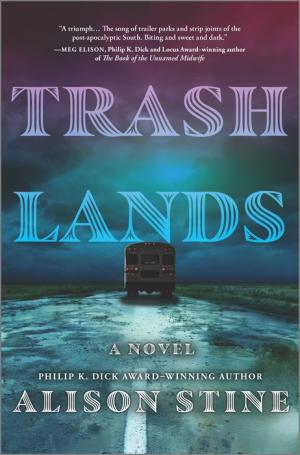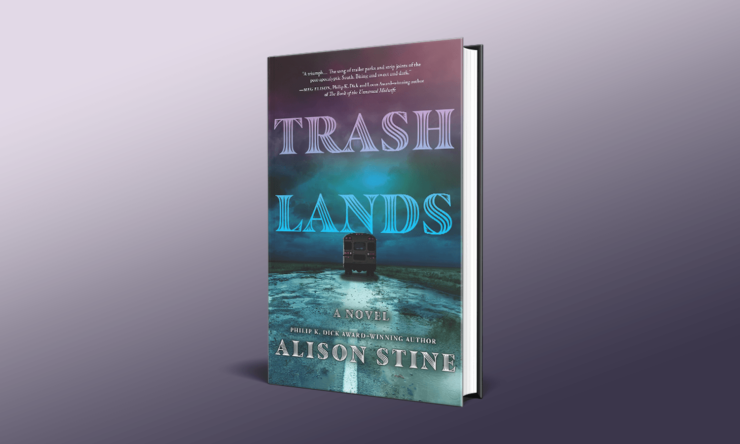It would be easy to take the title of Alison Stine’s second novel Trashlands at face value: It describes a near-future in which floods that “rewrote the map with more blue” carry the world’s plastic into Scrappalachia (as this North American region has been rechristened) for pluckers to trade and transform into daily objects—survival depends on reusing refuse. Trashlands is also the name of the area’s primary source of entertainment and business, a seedy strip club playing the same thumping bass on repeat beneath the only neon sign for miles. The connotations are there for readers to write off both the setting and its inhabitants, as the rest of their world has.
But as Stine demonstrates with her powerful second novel, even after the floods, there is still room for art.
Scrappalachia feels like it could be another point on that revised map a few weeks’ journey south of where the Traveling Symphony performs Shakespeare in Emily St. John Mandel’s Station Eleven. Or, alternately, a parallel universe set in the climate-ravaged Appalachia of Road Out of Winter, Stine’s Philip K. Dick Award-winning debut novel. Except instead of the first few seasons of an eternal winter, it’s a generation’s worth of ever-flowing and ever-eroding waters, that have reshaped not just the map but society itself: While the country’s more rural populations are indeed forced to be ever scrappier, the power is still on, albeit spottily, in “The Els”—short for The Elites, or the coastal cities.
Like the water, future generations have taken on more flow, moving from place to place to either escape climate ravages or follow the trail of trash to trade. Children are named, or rename themselves, according to nature and the natural world: after flowers and roots that sustain (protagonist Coral and her partner Trillium, Trashlands owner Rattlesnake Master), but also for cities that once stood or far-off locales (Coral’s son Shanghai, Trashlands bouncer Tahiti) only visited in the pages of Mr. Fall’s book of learning—or, in the case of the teacher and Coral’s adoptive father, after seasons that no longer exist.
Buy the Book


Trashlands
It’s the arrival of Miami, a reporter from The Els, that challenges the status quo of Trashlands, teetering like an unsteady trash pile: Searching for his missing sister, he stumbles upon the story of Trashlands and wants to commit it to semi-permanence in his newspaper. But instead, his presence—and his tendency to answer as many questions as he asks—disrupts the cycles that these characters have long adhered to, or gotten stuck in.
Stine has put deliberate rumination into how completely plastic makes up the worldbuilding, from describing the myriad recognizable trash that flows into the junkyard to jumping ahead several steps to the plastic slurry that makes the bricks that are rebuilding cities in The Els. But the most fascinating details are in how Trashlands’ residents repurpose plastic into everyday items: box shoes, chairs, mirrors, showers, makeup and tattooing inks and hair dye. Despite their different origins (and respective blacked-out portions of memory), they share remarkable ingenuity for envisioning every possible use for what in the before times was tossed without a second thought.
Which is why Coral’s art stands out so much—not even for the specific items she makes, but for their singular use. The young mother, working ceaselessly to earn enough money to buy back her son’s freedom from the plastic factory, mourns his absence through abstract pieces that she constructs from trash and nature (mud, sticks, and so forth). Yet she also works out her complicated feelings about motherhood through her art. Though it is one of many story threads, Stine makes a point of not sugarcoating the experience of any of the near-future’s mothers, most of whom are saddled with unplanned-for or unwanted children like a sea turtle choked in a six-pack’s plastic packaging. These she leaves in the woods instead of displaying in the junkyard; they might get vandalized or broken back down for parts the moment she turns her back, but at that point Coral has made her peace with the fate of her unpaid work. It’s a lovely contrast to her partner Trillium, who keeps them afloat by tattooing locals; Coral’s art will almost likely be destroyed immediately, whereas his will live on as long as its canvases do.
The chapters almost read like anecdotes from Miami’s newspaper—slice-of-life moments from a variety of perspectives, where we learn a lot yet not a lot of action occurs. Or rather, the changes are incremental: Two business associates acknowledge the feelings that have bloomed between them. Children in the factory outgrow their indentured servitude and are spit back out into a harsh world that has moved on without them. Trashlands loses some seasoned dancers but always replaces with fresh blood.
Ironically, Trashlands’ central theme is recycling. That’s the new lifespan—how many new lives, or second chances, can you have before you’re as worn out as a plastic bag that has no more transformations left? That’s the dilemma Coral faces: At barely thirty, she has already endured enough lifetimes as a pregnant child, a single mother, a plucker, a weathered woman, that to imagine another big change is near-impossible. Yet she has so much of her life left; Trashlands’ future is one that can be survived with her particular skills.
But neither Miami’s reporting nor Stine’s accounting are about sweeping cultural changes, because those have already happened: The world was altered in one big wave, and everything that follows are the ripples. What’s more vital are these day-to-day stories of survival, of people pushed to incredible creativity that readers like us could hardly fathom even as we fear the climate change bearing down within a generation.
“It was strange how the past and the future both felt bridged by impossible distance,” Coral reflects at one point. “You couldn’t reach either of them, couldn’t begin to imagine what you might find”—but just because the future is as unknowable as their lives before, doesn’t mean that it’s hurtling toward them. There is still time in the present for challenging ourselves to imagine more creative solutions—and for art, both permanent and temporary.
Trashlands is available from MIRA Books.
Natalie Zutter is a playwright and pop culture critic based in Brooklyn. She talks about SFF books, movies, and TV on Twitter.










